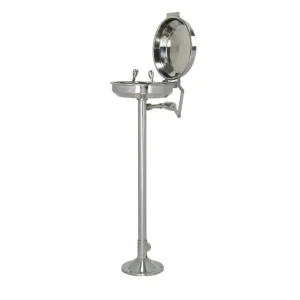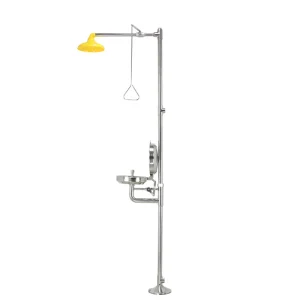In winter, temperatures drop. If eyewashes aren’t properly protected from freezing, internal pipes may freeze and expand, leading to pipe ruptures and damage, potentially affecting normal use in emergency situations. The following tips cover four aspects: equipment selection, installation layout, routine maintenance, and emergency response.
Equipment Selection
Choose a freeze-proof eyewash: Prefer eyewashes with freeze-proof designs. These typically feature structural optimizations, such as wrapping key components with special insulation or incorporating internal heating devices, to effectively prevent water from freezing in low temperatures. For example, some freeze-proof eyewashes are equipped with electric heating cables, which generate heat through electricity to keep the water temperature above freezing.
Consider Material Properties: Choose an eyewash made of a material with good cold resistance. For example, stainless steel eyewashes offer greater cold resistance and durability than some plastics. They maintain structural stability in low-temperature environments and are less susceptible to cracking due to the cold.
Installation Layout
Select a Suitable Site: Install the eyewash in a windproof, sunny location to minimize direct exposure to cold air. Avoid installing the eyewash near vents, in shadowed areas of buildings, or in low-lying areas, as these areas are typically cooler and more prone to ice formation. For example, choose to install the eyewash near a covered wall, which is both convenient for use and less susceptible to cold weather.
Insulation: Install insulation around the eyewash, such as wrapping the eyewash pipes and casing with insulation, foam board, or other materials. This insulation effectively prevents heat loss and maintains the internal temperature of the equipment. For eyewashes exposed outdoors, a simple insulation shed can be constructed to further enhance insulation.
Adjust the installation height: Raise the eyewash installation height appropriately, ensuring the drain outlet is clear of the ground. This allows water to flow more smoothly during drainage, reducing the possibility of water accumulating near the drain outlet and forming ice. A higher installation position also prevents groundwater from splashing onto the eyewash, causing ice to form.
Daily Maintenance
Drain the eyewash regularly: Drain the water at the end of each day or when the eyewash is not in use for an extended period. Open the eyewash’s drain valve and allow water to drain completely to prevent water from freezing inside the equipment. For some automatic drain eyewashes, ensure the drain is functioning properly and regularly check for drainage.
Keep the equipment dry: After using the eyewash, wipe the eyewash nozzle and surrounding water stains with a dry cloth to keep the equipment dry. Avoid allowing water to remain on the equipment for extended periods to reduce the risk of ice formation. Also, regularly clean snow and ice around the eyewash to ensure a clean and tidy environment.
Add antifreeze: Add an appropriate amount of antifreeze to the water in the eyewash to lower its freezing point. Choose an antifreeze suitable for use in the eyewash and add it according to the product instructions. After adding antifreeze, regularly check the concentration to ensure its effectiveness.
Emergency Measures
Prepare emergency heating equipment: Place emergency heating equipment near the eyewash, such as a hot air blower or hand warmer. If you notice signs of ice forming in the eyewash, use the heating equipment to heat the eyewash immediately to melt the ice. However, pay attention to the heating method and timing to avoid damage to the equipment due to localized overheating.
Develop an emergency plan: Develop an eyewash station anti-freezing emergency plan that clearly defines what to do if the eyewash station freezes and cannot be used properly. For example, designate the location and usage of backup eyewash stations to ensure that personnel can quickly find and use backup equipment in an emergency. Additionally, conduct regular drills of the emergency plan to enhance personnel’s emergency response capabilities.






